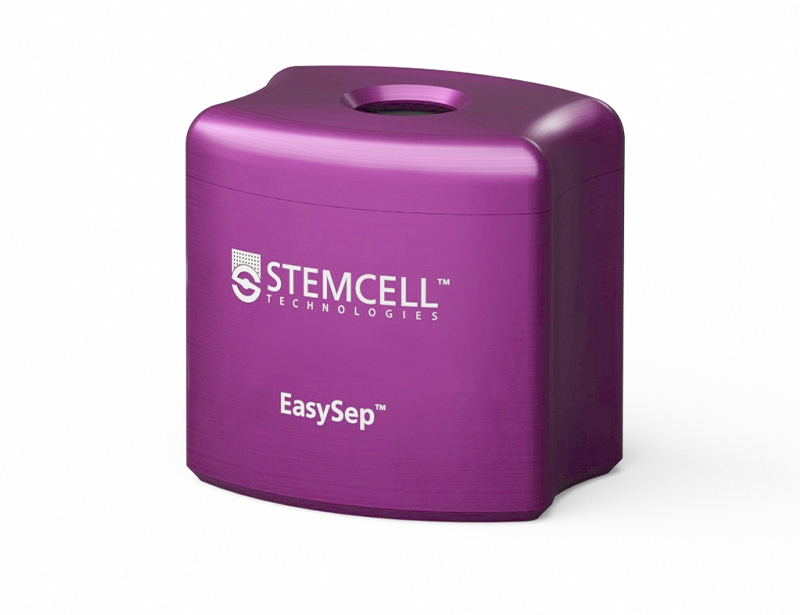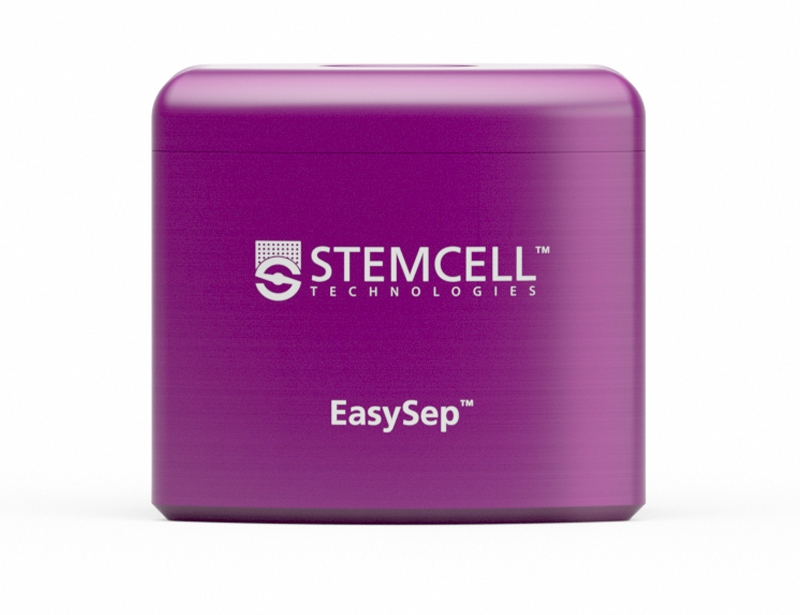概要
The EasySep™ Magnet is designed for cell separation procedures using EasySep™ reagents. The EasySep™ Magnet generates a high-gradient magnetic field in the interior cavity that is strong enough to separate cells labeled with EasySep™ Magnetic Particles without the use of columns. This magnet is designed to hold a standard 12 x 75 mm (5 mL) polystyrene tube.
技术资料
| Document Type | 产品名称 | Catalog # | Lot # | 语言 |
|---|---|---|---|---|
| Product Information Sheet | EasySep™ Magnet | 18000 | All | English |
数据及文献
Publications (6)
Clinical cancer research : an official journal of the American Association for Cancer Research 2019 may
Anti-CD105 Antibody Eliminates Tumor Microenvironment Cells and Enhances Anti-GD2 Antibody Immunotherapy of Neuroblastoma with Activated Natural Killer Cells.
Abstract
Abstract
Purpose: We determined whether elimination of CD105+ cells in the tumor microenvironment (TME) with anti-CD105 antibodies enhanced anti-disialoganglioside (GD2) antibody dinutuximab therapy of neuroblastoma when combined with activated natural killer (aNK) cells.Experimental Design: The effect of MSCs and monocytes on antibody-dependent cellular cytotoxicity (ADCC) mediated by dinutuximab with aNK cells against neuroblastoma cells was determined in vitro. ADCC with anti-CD105 mAb TRC105 and aNK cells against MSCs, monocytes, and endothelial cells, which express CD105, was evaluated. Anti-neuroblastoma activity in immunodeficient NSG mice of dinutuximab with aNK cells without or with anti-CD105 mAbs was determined using neuroblastoma cell lines and a patient-derived xenograft.Results: ADCC mediated by dinutuximab with aNK cells against neuroblastoma cells in vitro was suppressed by addition of MSCs and monocytes, and dinutuximab with aNK cells was less effective against neuroblastomas formed with coinjected MSCs and monocytes in NSG mice than against those formed by tumor cells alone. Anti-CD105 antibody TRC105 with aNK cells mediated ADCC against MSCs, monocytes, and endothelial cells. Neuroblastomas formed in NSG mice by two neuroblastoma cell lines or a patient-derived xenograft coinjected with MSCs and monocytes were most effectively treated with dinutuximab and aNK cells when anti-human (TRC105) and anti-mouse (M1043) CD105 antibodies were added, which depleted human MSCs and murine endothelial cells and macrophages from the TME.Conclusions: Immunotherapy of neuroblastoma with anti-GD2 antibody dinutuximab and aNK cells is suppressed by CD105+ cells in the TME, but suppression is overcome by adding anti-CD105 antibodies to eliminate CD105+ cells.
Leukemia 2019 mar
Selective targeting of multiple myeloma by B cell maturation antigen (BCMA)-specific central memory CD8+ cytotoxic T lymphocytes: immunotherapeutic application in vaccination and adoptive immunotherapy.
Abstract
Abstract
To expand the breadth and extent of current multiple myeloma (MM)-specific immunotherapy, we have identified various antigens on CD138+ tumor cells from newly diagnosed MM patients (n = 616) and confirmed B-cell maturation antigen (BCMA) as a key myeloma-associated antigen. The aim of this study is to target the BCMA, which promotes MM cell growth and survival, by generating BCMA-specific memory CD8+ CTL that mediate effective and long-lasting immunity against MM. Here we report the identification of novel engineered peptides specific to BCMA, BCMA72-80 (YLMFLLRKI), and BCMA54-62 (YILWTCLGL), which display improved affinity/stability to HLA-A2 compared to their native peptides and induce highly functional BCMA-specific CTL with increased activation (CD38, CD69) and co-stimulatory (CD40L, OX40, GITR) molecule expression. Importantly, the heteroclitic BCMA72-80 specific CTL demonstrated poly-functional Th1-specific immune activities [IFN-gamma/IL-2/TNF-alpha production, proliferation, cytotoxicity] against MM, which were correlated with expansion of Tetramer+ and memory CD8+ CTL. Additionally, heteroclitic BCMA72-80 specific CTL treated with anti-OX40 (immune agonist) or anti-LAG-3 (checkpoint inhibitor) display increased immune function, mainly by central memory CTL. These results provide the framework for clinical application of heteroclitic BCMA72-80 peptide, alone and in combination with anti-LAG3 and/or anti-OX40 therapy, in vaccination and/or adoptive immunotherapeutic strategies to generate long-lasting anti-tumor immunity in patients with MM or other BCMA expressing tumors.
Scientific reports 2019 apr
Cold-inducible RNA-binding Protein Induces Neutrophil Extracellular Traps in the Lungs during Sepsis.
Abstract
Abstract
Extracellular cold-inducible RNA-binding protein (CIRP) exaggerates inflammation and tissue injury in sepsis. Neutrophil extracellular traps (NETs) are released by activated neutrophils during sepsis. NETs contribute to pathogen clearance, but excessive NET formation (NETosis) causes inflammation and tissue damage. Peptidylarginine deiminase 4 (PAD4) is associated with NETosis by increasing histone citrullination and chromatin decondensation. We hypothesized that CIRP induces NETosis in the lungs during sepsis via upregulating PAD4 expression. Sepsis was induced in C57BL/6 wild-type (WT) and CIRP-/- mice by cecal ligation and puncture (CLP). After 20 h of CLP induction, NETs in the lungs of WT and CIRP-/- mice were quantified by flow cytometry by staining the single cell suspensions with MPO and CitH3 Abs. PAD4 expression in the lungs of WT and CIRP-/- mice after sepsis was assessed by Western blotting. In vitro effects of recombinant mouse (rm) CIRP for NETosis and PAD4 expression in the bone marrow-derived neutrophils (BMDN) were assessed by flow cytometry and Western blotting, respectively. After 20 h of CLP, NETosis in the lungs was significantly decreased in CIRP-/- mice compared to WT mice, which also correlated with the decreased PAD4 expression. Intratracheal administration of rmCIRP into WT mice significantly increased NETosis and PAD4 expression in the lungs compared to vehicle-injected mice. In vitro culture of BMDN with rmCIRP significantly increased NETosis and PAD4 expression compared to PBS-treated control. Fluorescence microscopy revealed typical web-like structures consistent with NETs in rmCIRP-treated BMDN. Thus, CIRP serves as a novel inducer of NETosis via PAD4 during sepsis.
PloS one 2019
Impact of selective immune-cell depletion on growth of Mycobacterium tuberculosis (Mtb) in a whole-blood bactericidal activity (WBA) assay.
Abstract
Abstract
We investigated the contribution of host immune cells to bacterial killing in a whole-blood bactericidal activity (WBA) assay, an ex vivo model used to test efficacy of drugs against mycobacterium tuberculosis (Mtb). We performed WBA assays with immuno-magnetic depletion of specific cell types, in the presence or absence of rifampicin. Innate immune cells decreased Mtb growth in absence of drug, but appeared to diminish the cidal activity of rifampicin, possibly attributable to intracellular bacterial sequestration. Adaptive immune cells had no effect with or without drug. The WBA assay may have potential for testing adjunctive host-directed therapies acting on phagocytic cells.
Nature methods 2017 JUN
Marker-free coselection for CRISPR-driven genome editing in human cells.
Abstract
Abstract
Targeted genome editing enables the creation of bona fide cellular models for biological research and may be applied to human cell-based therapies. Therefore, broadly applicable and versatile methods for increasing its efficacy in cell populations are highly desirable. We designed a simple and robust coselection strategy for enrichment of cells with either nuclease-driven nonhomologous end joining (NHEJ) or homology-directed repair (HDR) events by harnessing the multiplexing capabilities of CRISPR-Cas9 and Cpf1 systems. Selection for dominant alleles of the ubiquitous sodium/potassium pump (Na+/K+ ATPase) that rendered cells resistant to ouabain was used to enrich for custom genetic modifications at another unlinked locus of interest, thereby effectively increasing the recovery of engineered cells. The process is readily adaptable to transformed and primary cells, including hematopoietic stem and progenitor cells. The use of universal CRISPR reagents and a commercially available small-molecule inhibitor streamlines the incorporation of marker-free genetic changes in human cells.
Nature Protocols 2015 NOV
Efficient delivery of nuclease proteins for genome editing in human stem cells and primary cells.
Abstract
Abstract
Targeted nucleases, including zinc-finger nucleases (ZFNs), transcription activator-like (TAL) effector nucleases (TALENs) and clustered regularly interspaced short palindromic repeat (CRISPR)/CRISPR-associated protein 9 (Cas9), have provided researchers with the ability to manipulate nearly any genomic sequence in human cells and model organisms. However, realizing the full potential of these genome-modifying technologies requires their safe and efficient delivery into relevant cell types. Unlike methods that rely on expression from nucleic acids, the direct delivery of nuclease proteins to cells provides rapid action and fast turnover, leading to fewer off-target effects while maintaining high rates of targeted modification. These features make nuclease protein delivery particularly well suited for precision genome engineering. Here we describe procedures for implementing protein-based genome editing in human embryonic stem cells and primary cells. Protocols for the expression, purification and delivery of ZFN proteins, which are intrinsically cell-permeable; TALEN proteins, which can be internalized via conjugation with cell-penetrating peptide moieties; and Cas9 ribonucleoprotein, whose nucleofection into cells facilitates rapid induction of multiplexed modifications, are described, along with procedures for evaluating nuclease protein activity. Once they are constructed, nuclease proteins can be expressed and purified within 6 d, and they can be used to induce genomic modifications in human cells within 2 d.

 网站首页
网站首页





